By Paul Guzzo, University Communications and Marketing
Jimmy Carter was described as the “active ex-president” when awarded the Nobel Peace Prize in 2002.
The Nobel Foundation’s website lists his post-presidential accomplishments as including teaching Sunday school, volunteering for Habitat for Humanity and establishing the Carter Foundation, which seeks to “resolve conflict, promote democracy, protect human rights and prevent disease.”
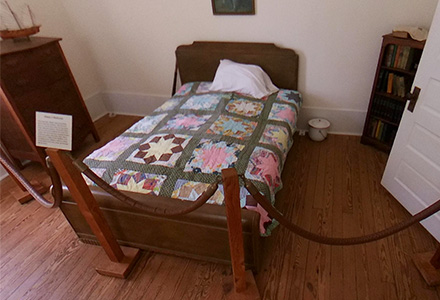
President Jimmy Carter's boyhood bedroom
Carter, who died on Dec. 29, was once so active that some might wonder if he ever slept.
He did, and the University of South Florida’s Center for Digital Heritage and Geospatial Information has proof.
Since 2021, the center has been working to virtually document nearly every inch of the Jimmy Carter National Historical Park in Plains, Georgia.
That effort has included laser-scanning his bed and then recreating an exact virtual 3D model as part of their work to preserve and share historic sites.
The original bed was crafted by the ever-industrious Carter, who, as a master of woodworking, carved and made it himself.
“Through his whole life, he has had a passion for woodwork,” said Lori Collins, the center’s co-director. “That is part of his story we want to now share with the world.”
He was also a politician, humanitarian, family man and farmer, each of which is also part of the story the center is telling through their USF research program.
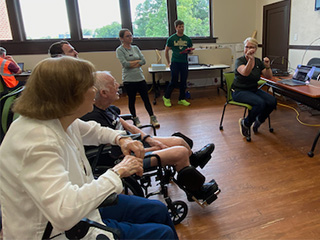
USF team presented to President Carter and First Lady Rosalynn Carter at the Plains High School in 2021 [Photo courtesyt: NPS JICA]
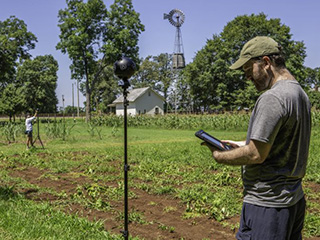
USF’s Benjamin Mittler and Denise Wright work to capture 360 terrains at the Jimmy Carter Boyhood Farm. [Photo courtesy: Frank Rodriquez]
![USF's Center for Digital Heritage and Geospatial Information 3D scans President Jimmy Carter's daybed. [Photo courtesy of Lori Collins]](/news/images/2025/usf-memorializes-former-president-jimmy-carter-with-3d-virtual-tour-of-boyhood-farm/snip3.jpg)
USF's Center for Digital Heritage and Geospatial Information 3D scans President Jimmy Carter's daybed. [Photo courtesy: Lori Collins]
In partnership with the National Park Service, Collins’s team includes co-director Travis Doering and 3D heritage specialists Jorge Gonzalez and Noelia Garcia. Using advanced technologies, such as laser scanning, photogrammetry and 3D modeling, they have so far created virtual tours of the 39th president’s boyhood farm, high school he attended and railroad depot that served as campaign headquarters for his successful 1976 presidential bid, all of which are part of the federal government-managed 71-acre park.

3D scan of President Jimmy Carter's campaign headquarters
Those tours are available online for free.
They have yet to document Carter’s former private residence, which is bequeathed to the National Park Service to become part of the park, “but are looking forward to doing so in the future,” Collins said.
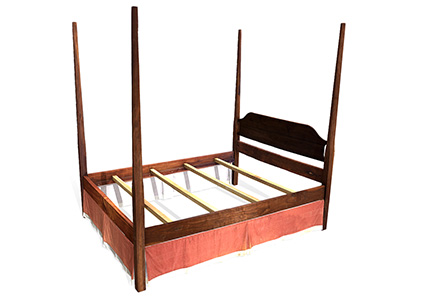
Jimmy Carter's post-presidency bed
The center has 3D documented about 25 furniture pieces Carter hand-made throughout his lifetime. Of those, 20 are now available online and embedded for viewing as part of the immersive virtual tours.
Collins has a favorite piece – Carter’s walnut wood queen-sized four-post bed.
“It’s an example of why we do what we do, which is to preserve history,” she said. “Our data can later be used for interpretive and preservation needs, including exacting replica production.”
The simple, yet stately piece of furniture was Carter’s bed while in the White House and then used post-presidency at his Plains home. It has recently been given to Carter’s son, Chip. The National Park Service plans to use the USF model to recreate a copy of the original to replace the removed piece when the Plains home is one day opened for public tours.
Since the team made two, seven-day trips to Plains in 2021 as part of the documentation fieldwork, they have further partnered with the National Park Service to develop a research plan to work with chosen artisans to recreate the former president’s woodworking and develop a future exhibition of replica furniture pieces.
“It is common for me to work with our partners like the National Park Service to develop spin-off grants and research projects,” Collins says. “Whether it is a digital surrogate for archival documentation, a replica or a visualization, we are often asked if it is possible to do different outcomes.”

Carter barn
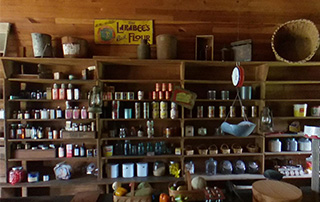
Carter commissary
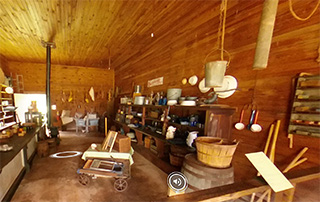
Carter blacksmith shop
During one of their visits to the park, they had the opportunity to spend time with and explain their research techniques to Carter and the former first lady, Rosalyn Carter.
“I am honored to have played a small role in remembering the life of President Carter through the documentation of his life's work with woodworking,” Doering said. “Meeting the president and hearing him reflect on the meaning behind each furniture piece and the care and love that went into designs was amazing to see.”
![USF's Center for Digital Heritage and Geospatial Information at the railroad depot that served as Jimmy Carter's presidential campaign headquarters. [Photo courtesy of Lori Collins]](/news/images/2025/usf-memorializes-former-president-jimmy-carter-with-3d-virtual-tour-of-boyhood-farm/visit-1.jpg)
USF's Center for Digital Heritage and Geospatial Information at the railroad depot that served as Jimmy Carter's presidential campaign headquarters. [Photo courtesy: Lori Collins]
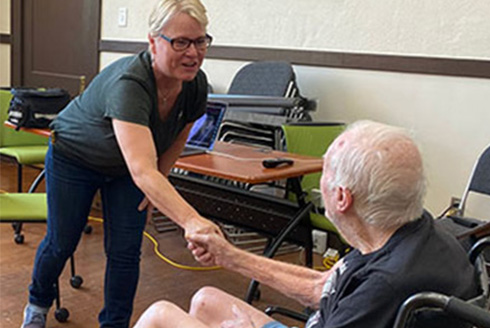
Lori Collins meeting President Jimmy Carter [Photo courtesy: Lori Collins]
“He has always been an inspirational figure to me,” Collins said. “He always asked people around him, ‘What are you doing to make a difference today?”
The center has made a difference by digitally recording, preserving and sharing historic sites and artifacts with the world.
“Our work serves as a bridge between the past and the future,” Collins said. “We are safeguarding the stories, knowledge and identities tied to cultural and natural heritage, ensuring they endure for future generations.”

A 3D scan of President Jimmy Carter's boyhood farm. [Photo courttsy of Lori Collins]
The center has 3D scanned and documented historic sites throughout Europe and across the United States, including Cape Canaveral and St. Augustine’s Castillo de San Marcos masonry fort.
Before the existence of the necessary technologies, such places could only be enjoyed by those with the means to travel. Virtual and 3D representations now open those sites more easily to the world.
As part of their virtual reconstruction research, the center first gathers background materials and works with collaborators to understand the historical context and significance of what they are documenting. Prior to data collection, a physical tour of the site allows holistic planning for their work.
“That’s when we plot how we are going to attack the project,” she said.
They detail what needs to be captured, storyboard their virtual tour, and then 3D laser scan the objects and sites.
Different 3D laser scanners, from handheld devices to those that look like survey equipment mounted to tripods, capture intricacies from a distance without objects having to be handled. The results range from sub-millimetric to millimetric precision, creating a digital twin of whatever is being documented.
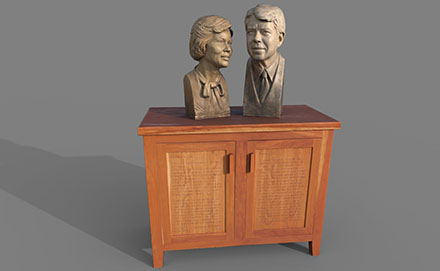
3D scans of busts of Rosalyn and Jimmy Carter. [Photo courtesy: Lori Collins]
Those capabilities are on full display in the virtual tour of the 39th president’s childhood farm. It includes a close-up look at every tool in the blacksmith shop, plus a model of a Chinese junk ship that has been on display in Carter’s boyhood room since it was gifted by an uncle stationed in the Pacific.
"By documenting these places and objects through 3D technology, we are preserving a vital aspect of President Carter's legacy — a legacy that reflects the profound intersection of art, history and leadership," Collins said. "Our work ensures that future generations will have access to these pieces, not just as examples of enduring craftsmanship, but as symbols of a life devoted to service, humility and humanitarian values. I hope that through our research, we continue to honor and share the richness of President Carter’s remarkable life and legacy."
LINKS
Virtual Tour of the Plains Depot Campaign Headquarters
The Woodworking of President Jimmy Carter